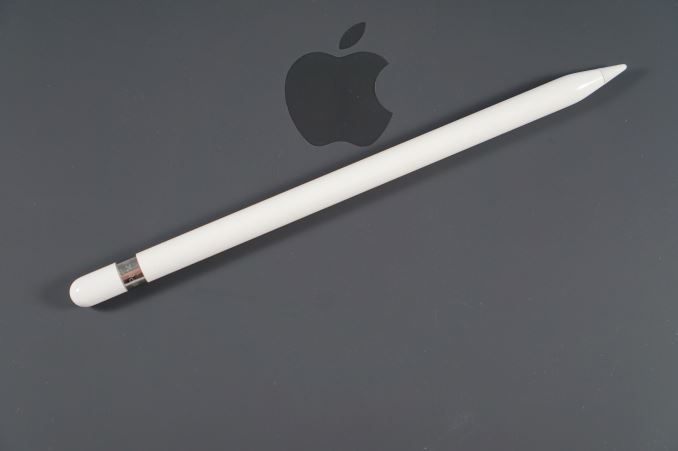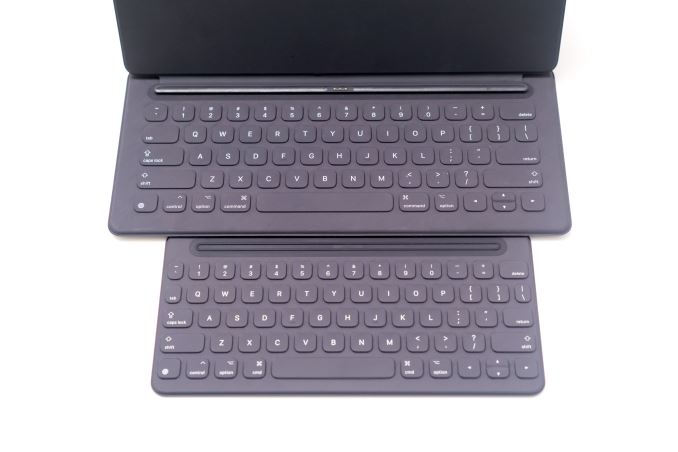The 9.7" iPad Pro Review
by Brandon Chester on June 1, 2016 9:00 AM ESTA Smaller iPad Pro
When the 12.9” iPad Pro was the only iPad Pro, the appeal it had was fairly obvious. Supporting Apple Pencil and the Smart Keyboard brought the iPad experience to a whole new level, and the large display allowed for an enormous canvas for full screen apps, as well as two essentially full sized iPad apps side by side. Of course, the large display also made the iPad Pro much less portable than Apple’s other iPads. Now that the 9.7” iPad is also an iPad Pro, it appears that Apple doesn’t consider the display size as playing a role in what defines an iPad as an iPad Pro. With that factor eliminated, it seems that Apple’s criteria for the iPad Pro is that it supports the Apple Pencil and Smart Keyboard, and is powered by the fastest ARM SoCs that Apple can produce.
While the 9.7” iPad Pro shares a name with the 12.9” model, I think the use cases for each are quite different. Much of this comes down to what sort of application workflow you can have given the constraints of the display. In turn, this changes how you use the Apple Pencil and Smart Keyboard, and so it’s worth going over how the experience with these accessories translates to the smaller iPad Pro.
Given that it’s by far my most used accessory, I’d like to begin with the Apple Pencil. The Apple Pencil was the first stylus that I ever used where I felt that it could truly replace my paper notebook and pencils for note taking. The Surface Pro 4 is an awesome device, but the integration of the Surface Pen within apps and the OS isn’t at the same level as the iPad Pro, and the accuracy and latency of the pen itself aren’t either. The 12.9” iPad Pro is particularly useful for taking notes in an academic setting, as you’re able to keep one application open for taking notes and another for viewing web resources, lecture slides, or a textbook. The 9.7” doesn’t have the same ability, and for the kind of use case where you need to be writing things by referencing other material, I think the 12.9” model has an obvious advantage.
However, the 9.7” iPad Pro excels in other situations, and for my current work I actually prefer it to the 12.9” model because I find myself needing to take notes in meetings. In a setting where you don’t need to reference other materials, the ability to use the 9.7” iPad Pro comfortably while standing and the fact that its size and mass makes it easy to pass around makes it a much more appealing device. You can almost treat it like a pad of paper on a clipboard in some respects, and that’s something you definitely cannot do with the larger iPad Pro.
For me, the Smart Keyboard is a different story. I have the Smart Keyboard for the 12.9” iPad Pro, but I never ever use it. The only occasion where I found myself using it was when I had to use a terminal application to SSH into servers to do some work, and that’s an almost hilariously niche use case for an iPad. Beyond that, I never felt that the keyboard provided any advantage to me compared to just using the on-screen keyboard. On top of that, the added mass is significant, and with the Smart Keyboard attached to the 12.9” iPad Pro the mass of the full package ends up being quite high for what I perceive as little to no benefit. Obviously there are situations where the keyboard can be helpful, such as working on documents or writing a review such as this one, but for my work my computer is still an active part of my day, and when I’m using the iPad I’d rather write things down with the Apple Pencil than type them out.
With the 9.7” Smart Keyboard Apple does address a couple of my issues with the larger one. For one, it’s obviously much lighter due to its smaller size. It’s actually light enough that I wouldn’t really mind if I had to keep it attached to the iPad as a cover, but I still opt not to because it does impact the usability of the device when you hold it while the cover is folded around the back. What hasn’t been addressed is the unsightly folded design which is awkward to set up, and the fact that it honestly isn’t the most compelling accessory despite commanding such a high price.
While the Smart Keyboard probably isn’t for me, I’m sure there are many users who are interested it and are wondering what sort of experience you get from the smaller version. I originally saw concerns about the usability of a smaller keyboard, but I don’t think the 9.7” Smart Keyboard is any worse than the 12.9” version. The smaller keys take some time to get used to, but you do get used to it. The travel distance is equivalent to the larger one, and so the feel of the keys themselves hasn’t changed, which is either a good or bad thing depending on how you feel about the larger Smart Keyboard. Honestly it really is just a shrunken down version of the other Smart Keyboard, and as a keyboard it works okay, but there’s not a whole lot to say beyond that.
Ultimately, the 9.7" iPad Pro provides the same feature set as the larger model, but there are obvious limitations caused by the smaller display. Workflows that require viewing two full iPad applications at the same time don't really work, and there are certain apps like Paper and Adobe's Photoshop suite where the 12.9" iPad Pro has a significant advantage due to the larger canvas. On the other hand, the 9.7" model's portability opens up use cases where the larger model is too cumbersome to use, particularly situations where you have to hold the iPad for a considerable period of time. As with most devices that come in multiple sizes, you'll have to decide for yourself which one better suits your needs. On the iPad Pro you can at least be sure that no matter which one you choose, you won't be missing out on any of the features that differentiate the iPad Pro from the rest of the line.












144 Comments
View All Comments
dannyzhukovets - Thursday, June 2, 2016 - link
Thank you very much for this review. iPad is a work tool for me, use is in my semi-truck.Replaced my iPad 3 (the first iPad with retina display) with this new 9.7 Pro and gut disappointed again. Paid $1030 for top version to find out that it lacks RAM and won't be a great long term investment like I desired from a product with Pro tag.
Thinking to update to iOS 11 later this year and then refuse to update to iOS 12 in 2017 and after...
Commodus - Sunday, June 5, 2016 - link
Yeah, you won't want to pour a ton of money into the iPad Pro unless you know it'll be your only mobile computer and you specifically need as much storage or connectivity as possible.Also, I think you mean iOS 10, given that we're still on iOS 9... unless you've found a way to travel a year into the future.
grayson_carr - Thursday, June 2, 2016 - link
Love the display uniformity tests! Thank you! It always makes me mad that Samsung's AMOLED displays get great marks for calibration, but no one mentions or tests their uniformity. Spoiler! They have terrible uniformity! Most S6 and S7 samples I have come across have white uniformity so bad that the unevenness can be seen with the naked eye in the form of pink or green tints across portions of the displays. It would be cool if you could retroactively test the uniformity of a couple recent Samsung phones.Brandon Chester - Thursday, June 2, 2016 - link
I forgot to mention this but it's impossible to do on a phone beyond something like a four corner test. The meter is too big relative to the display. When the next Samsung tablets roll around I will definitely be using this test, so keep your eyes open.grayson_carr - Monday, June 13, 2016 - link
Aw, dang. Makes sense. I still think a simple 4 corner test would be useful though.GC2:CS - Friday, June 3, 2016 - link
It would be deffinitelly good to make some broader tests.I actually heard that oleds have near perfect uniformity considering they lack the backlight that is bassically causing that problem. Might be kind of poor argument as I don't think that laying down oled sandwiches is perfect either... And differently aging colors can take a big tool in this metric over time for sure.
AbRASiON - Saturday, June 4, 2016 - link
WARNING:I picked up one of these 3 weeks back, I happen to use it in bed, at night, quietly. It's how I like to go to sleep.
In a silent room, you can CLEARLY hear the buzz of the LCD driving chip, just put your eat right where the volume rocker is in a very quiet environment, then scroll the screen with your hand. It's quite annoying.
My Air 2, didn't do this.
Brandon Chester - Saturday, June 4, 2016 - link
I have it on the table next to me and there's no noise. You might want to get it replaced.R. Hunt - Monday, June 6, 2016 - link
Say what you will, I'm never going back to LCD on a tablet, no matter how good. They're still crap.grayson_carr - Monday, June 13, 2016 - link
Why? Because they don't make photos look like they were taken in a neon cartoon world like AMOLED screens do?